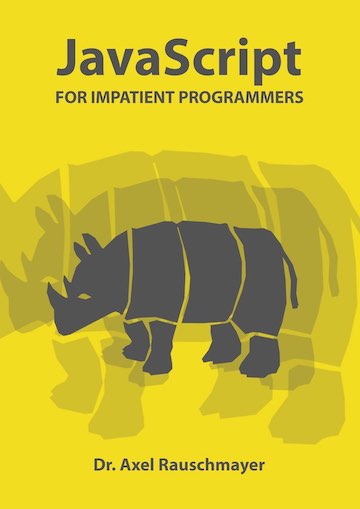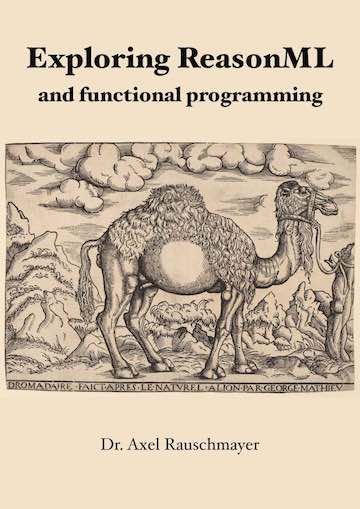Understanding TypeScript’s type notation
This blog post is a quick introduction to TypeScript’s notation for static types.
What you’ll learn
After reading this post, you should be able to understand what the following code means:
interface Array<T> {
concat(...items: Array<T[] | T>): T[];
reduce<U>(
callback: (state: U, element: T, index: number, array: T[]) => U,
firstState?: U): U;
···
}
If you think this is cryptic – then I agree with you. But (as I hope to prove) this notation is relatively easy to learn. And once you understand it, it gives you immediate, precise and comprehensive summaries of how code behaves. No need to read long descriptions in English.
Trying out the code examples
TypeScript has an online playground. In order to get the most comprehensive checks, you should switch on everything in the “Options” menu. This is equivalent to running the TypeScript compiler in --strict mode.
Specifying the comprehensiveness of type checking
I always use TypeScript with the most comprehensive setting, --strict. Without it, programs are slightly easier to write, but you also lose many benefits of static type checking. Currently, this setting enables the following sub-settings:
--noImplicitAny: If TypeScript can’t infer a type, you must specify it. This mainly applies to parameters of functions and methods: With this settings, you must annotate them.--noImplicitThis: Complain if the type ofthisisn’t clear.--alwaysStrict: Use JavaScript’s strict mode whenever possible.--strictNullChecks:nullis not part of any type (other than its own type,null) and must be explicitly mentioned if it is a acceptable value.--strictFunctionTypes: stronger checks for function types.--strictPropertyInitialization: If a property can’t have the valueundefined, then it must be initialized in the constructor.
More info: chapter “Compiler Options” in the TypeScript Handbook.
Types
In this blog post, a type is simply a set of values. The JavaScript language (not TypeScript!) has 7 types:
- Undefined: the set with the only element
undefined. - Null: the set with the only element
null. - Boolean: the set with the two elements
falseandtrue. - Number: the set of all numbers.
- String: the set of all strings.
- Symbol: the set of all symbols.
- Object: the set of all objects (which includes functions and arrays).
All of these types are dynamic: you can use them at runtime.
TypeScript brings an additional layer to JavaScript: static types. These only exist when compiling or type-checking source code. Each storage location (variable or property) has a static type that predicts its dynamic values. Type checking ensures that these predictions come true. And there is a lot you can check statically (without running the code). If, for example the parameter x of a function f(x) has the static type number, then the function call f('abc') is illegal, because the parameter 'abc' has the wrong static type.
Type annotations
A colon after a variable name starts a type annotation: the type signature after the colon describes what values the variable can have. For example, the following line tells TypeScript that x will only ever store numbers:
let x: number;
You may wonder if x being initialized with undefined doesn’t violate the static type. TypeScript gets around this problem by not letting you read x before you assign a value to it.
Type inference
Even though every storage location has a static type in TypeScript, you don’t always have to explicitly specify it. TypeScript can often infer it. For example, if you write:
let x = 123;
Then TypeScript infers that x has the static type number.
Describing types
What comes after the colon of a type annotation is a so-called type expression. These range from simple to complex and are created as follows.
Basic types are valid type expressions:
- Static types for JavaScript’s dynamic types:
undefined,nullboolean,number,stringsymbolobject.- Note: value
undefinedvs. typeundefined(depends on locations)
- TypeScript-specific types:
Array(not technically a type in JS)any(the type of all values)- Etc.
Note that “undefined as a value” and “undefined as a type” are both written as undefined. Depending on where you use it, it is interpreted as a value or as a type. The same is true for null.
You can create more type expressions by combining basic types via type operators, which combine types similarly to how the operators union (∪) and intersection (∩) combine sets.
The following sections explain a few of the type operators that TypeScript offers.
Array types
Arrays are used in the following two roles in JavaScript (and sometimes a mix of the two):
- Lists: All elements have the same type. The length of the Array varies.
- Tuple: The length of the Array is fixed. The elements do not necessarily have the same type.
Arrays as lists
There are two ways to express the fact that the Array arr is used as a list whose elements are all numbers:
let arr: number[] = [];
let arr: Array<number> = [];
Normally, TypeScript can infer the type of a variable if there is an assignment. In this case, you actually have to help it, because with an empty Array, it can’t determine the type of the elements.
We’ll get back to the angle brackets notation (Array<number>) later.
Arrays as tuples
If you store a two-dimensional point in an Array then you are using that Array as a tuple. That looks as follows:
let point: [number, number] = [7, 5];
In this case, you don’t need the type annotation.
Another example for tuples is the result of Object.entries(obj): an Array with one [key, value] pair for each property of obj.
> Object.entries({a:1, b:2})
[ [ 'a', 1 ], [ 'b', 2 ] ]
The type of the result of Object.entries() is:
Array<[string, any]>
Function types
This is an example of a function type:
(num: number) => string
This type comprises all functions that accept a single parameter, a number, and return a string. Let’s use this type in a type annotation (String is used as a function here):
const func: (num: number) => string = String;
Again, we normally wouldn’t use a type annotation here, because TypeScript knows the type of String and can therefore infer the type of func.
The following code is a more realistic example:
function stringify123(callback: (num: number) => string) {
return callback(123);
}
We are using a function type to describe the parameter callback of stringify123(). Due to this type annotation, TypeScript rejects the following function call.
f(Number);
But it accepts the following function call:
f(String);
Result types of function declarations
It’s a good practice to annotate all parameters of functions. You can also specify the result type (but TypeScript is quite good at inferring it):
function stringify123(callback: (num: number) => string): string {
const num = 123;
return callback(num);
}
The special result type void
void is a special result type for functions: It tells TypeScript that the function always returns undefined (explicitly or implicitly):
function f1(): void { return undefined } // OK
function f2(): void { } // OK
function f3(): void { return 'abc' } // error
Optional parameters
A question mark after an identifier means that the parameter is optional. For example:
function stringify123(callback?: (num: number) => string) {
const num = 123;
if (callback) {
return callback(num); // (A)
}
return String(num);
}
If you run TypeScript in --strict mode, it will only let you make the function call in line A if you check beforehand that callback hasn’t been omitted.
Parameter default values
TypeScript supports ES6 parameter default values:
function createPoint(x=0, y=0) {
return [x, y];
}
Default values make parameters optional. You can usually omit type annotations, because TypeScript can infer the types. For example, it can infer that x and y both have the type number.
If you wanted to add type annotations, that would look as follows.
function createPoint(x:number = 0, y:number = 0) {
return [x, y];
}
Rest types
You can also use the ES6 rest operator for TypeScript parameter definitions. The type of the corresponding parameter must be an Array:
function joinNumbers(...nums: number[]): string {
return nums.join('-');
}
joinNumbers(1, 2, 3); // '1-2-3'
Union types
In JavaScript, variables occasionally have one of several types. To describe those variables, you use union types. For example, in the following code, x is either of type null or of type number:
let x = null;
x = 123;
The type of x can be described as null|number:
let x: null|number = null;
x = 123;
The result of the type expression s|t is the set-theoretic union of the types s and t (which, as we have seen earlier, as both sets).
Let’s rewrite function stringify123(): This time, we don’t want the parameter callback to be optional. It should always be mentioned. If callers don’t want to provide a function, they have to explicitly pass null. That is implemented as follows.
function stringify123(
callback: null | ((num: number) => string)) {
const num = 123;
if (callback) { // (A)
return callback(123); // (B)
}
return String(num);
}
Note that, once again, we have to check if callback is actually a function (line A), before we can make the function call in line B. Without the check, TypeScript would report an error.
Optional vs. undefined|T
Optional parameters of type T and parameters of type undefined|T are quite similar. (As an aside, the same is true for optional properties.)
The main difference is that you can omit optional parameters:
function f1(x?: number) { }
f1(); // OK
f1(undefined); // OK
f1(123); // OK
But you can’t omit parameters of type undefined|T:
function f2(x: undefined | number) { }
f2(); // error
f2(undefined); // OK
f2(123); // OK
The values null and undefined are not generally included in types
In many programming languages, null is part of all types. For example, whenever the type of a parameter is String in Java, you can pass null and Java won’t complain.
In contrast, in TypeScript, undefined and null are handled by separate, disjoint types. You need a type union such as undefined|string and null|string, if you want to allow them.
Typing objects
Similarly to Arrays, objects play two roles in JavaScript (that are occasionally mixed and/or more dynamic):
-
Records: A fixed amount of properties that are known at development time. Each property can have a different type.
-
Dictionaries: An arbitrary amount of properties whose names are not known at development time. All property keys (strings and/or symbols) have the same type, as do the property values.
We’ll ignore objects-as-dictionaries in this blog post. As an aside, Maps are usually a better choice for dictionaries, anyway.
Typing objects-as-records via interfaces
Interfaces describe objects-as-records. For example:
interface Point {
x: number;
y: number;
}
One big advantage of TypeScript’s type system is that it works structurally, not nominally. That is, interface Point matches all objects that have the appropriate structure:
function pointToString(p: Point) {
return `(${p.x}, ${p.y})`;
}
pointToString({x: 5, y: 7}); // '(5, 7)'
In contrast, Java’s nominal type system requires classes to implement interfaces.
Optional properties
If a property can be omitted, you put a question mark after its name:
interface Person {
name: string;
company?: string;
}
Methods
Interfaces can also contain methods:
interface Point {
x: number;
y: number;
distance(other: Point): number;
}
Type variables and generic types
With static typing, you have two levels:
- Values exist at the object level.
- Types exist at a meta level.
Similarly:
- Normal variables exist at the object level.
- There are also type variables, which exist at the meta level. They are variables whose values are types.
Normal variables are introduced via const, let, etc. Type variables are introduced via angle brackets (< >). For example, the following code contains the type variable T, as introduced via <T>.
interface Stack<T> {
push(x: T): void;
pop(): T;
}
You can see that the type parameter T appears twice inside the body of Stack. Therefore, this interface can intuitively understood as follows:
Stackis a stack of values that all have a given typeT. You must fill inTwhenever you mentionStack. We’ll see how, next.- Method
.push()accepts values of typeT. - Method
.pop()returns values of typeT.
If you use Stack, you must assign a type to T. The following code shows a dummy stack, whose only purpose is to match the interface.
const dummyStack: Stack<number> = {
push(x: number) {},
pop() { return 123 },
};
Example: Maps
Maps are typed generically in TypeScript. For example:
const myMap: Map<boolean,string> = new Map([
[false, 'no'],
[true, 'yes'],
]);
Type variables for functions
Functions (and methods) can introduce type variables, too:
function id<T>(x: T): T {
return x;
}
You use this function as follows.
id<number>(123);
Due to type inference, you can also omit the type parameter:
id(123);
Passing on type parameters
Functions can pass on their type parameters to interfaces, classes, etc.:
function fillArray<T>(len: number, elem: T) {
return new Array<T>(len).fill(elem);
}
The type variable T appears three times in this code:
fillArray<T>: introduce the type variableelem: T: use the type variable, pick it up from the argument.Array<T>: pass onTto theArrayconstructor.
That means: we don’t have to explicitly specify the type T of Array<T> – it is inferred from parameter elem:
const arr = fillArray(3, '*');
// Inferred type: string[]
Conclusion
Let’s use what we have learned to understand the piece of code we have seen earlier:
interface Array<T> {
concat(...items: Array<T[] | T>): T[];
reduce<U>(
callback: (state: U, element: T, index: number, array: T[]) => U,
firstState?: U): U;
···
}
This is an interface for an Array whose elements are of type T that we have to fill in whenever we use this interface:
-
method
.concat()has zero or more parameters (defined via the rest operator). Each of those parameters has the typeT[]|T. That is, it is either an Array ofTvalues or a singleTvalue. -
method
.reduce()introduces its own type variable,U.Uexpresses the fact that the following entities all have the same type (which you don’t need to specify, it is inferred automatically):- Parameter
stateofcallback()(which is a function) - Result of
callback() - Optional parameter
firstStateof.reduce() - Result of
.reduce()
callbackalso gets a parameterelementwhose type has the same typeTas the Array elements, a parameterindexthat is a number and a parameterarraywithTvalues. - Parameter
Further reading
- Book (free to read online): “Exploring ES6”
- “ECMAScript Language Types” in the ECMAScript specification.
- “TypeScript Handbook”: is well-written and explains various other kinds of types and type operators that TypeScript supports.
- The TypeScript repository has type definitions for the complete ECMAScript standard library. Reading them is an easy way of practicing the type notation.




